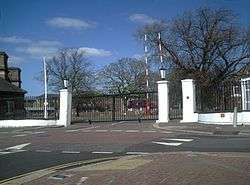Cavalry Barracks, Hounslow
| Cavalry Barracks, Hounslow | |
|---|---|
| Hounslow | |
|
Cavalry Barracks, Hounslow | |
 Cavalry Barracks, Hounslow Location within Greater London | |
| Coordinates | 51°28′10″N 00°23′21″W / 51.46944°N 0.38917°WCoordinates: 51°28′10″N 00°23′21″W / 51.46944°N 0.38917°W |
| Type | Barracks |
| Site information | |
| Owner | Ministry of Defence |
| Operator |
|
| Site history | |
| Built | 1793 |
| Built for | War Office |
| In use | 1793-Present |
| Garrison information | |
| Occupants | Irish Guards |
Cavalry Barracks is a British Army installation located north of Hounslow Heath in Hounslow, west London. Hounslow was one of 40 new barracks established around London to guard against possible French invasion in the late 18th and early 19th centuries.
History
The area around Hounslow Heath has been used for centuries to garrison Armies of The Crown because of its proximity to London, Windsor Castle and Hampton Court Palace. In the 17th century, Oliver Cromwell marshalled an army on the heath at the end of the English Civil War in 1647. James II also camped his troops here to hold military exercises in an unsuccessful attempt to intimidate the Parliament in London shortly before the Glorious Revolution.[1]
In 1793, the area became a permanent barracks for troops using the heath when permanent buildings were erected as part of the British response to the threat of the French Revolution. The barracks became a busy depot for the London military district. Florence Nightingale undertook some of her early training at Hounslow.[2]
In June 1846, Private Frederick John White was flogged after a Court-martial sentenced him to 150 lashes for insubordination at Hounslow Barracks. He died a month later making him the last soldier to die after a flogging in the British Army. White was buried in nearby St Leonard's churchyard, Heston. Calls for abolishment of flogging were made in Parliament; it was eventually outlawed in 1881.[3]
In 1875 the site was significantly expanded to create infantry barracks. Two years earlier a system of recruiting areas based on counties was instituted under the Cardwell Reforms and the barracks became the depot for the two battalions of the 7th Regiment of Foot.[4] Following the Childers Reforms, the regiment evolved to become the Royal Fusiliers with its depot in the barracks in 1881.[4] In 1875 the barracks also became the depot for the 57th (West Middlesex) Regiment of Foot and the 77th (East Middlesex) Regiment of Foot.[4] Following the Childers Reforms, the 57th and 77th regiments amalgamated to form the Middlesex Regiment with its depot in the barracks in 1881.[4] By 1884, the barracks had its own railway station on the newly created London Underground.[5]
After the Second World War the barracks served as Headquarters Eastern Command until it moved to Wilton Park in 1954.[6]
In late 1941, the 70th Battalion the Middlesex Regiment moved into Hounslow Cavalry Barracks. Known as the "Young Soldiers Battalion" because they were all 18- and 19-year-old volunteers, they remained there at the barracks until they moved over the road into Beavers Lane Camp in 1942. Hounslow was the first time the troops had been formed together as a battalion since their formation in May 1940, having been scattered in small units in and around London guarding Vulnerable Points (VPs).[7]
Until the 1970s, Cavalry Barracks was home to the (Army's) West London Communication Centre and the Hounslow Regimental Pay Office manned by members of the Royal Army Pay Corps.[8]
From 1981 to 1986, Cavalry barracks was the home of the 1st Bn Grenadier Guards (1st Foot Guards). During their stay they mounted public duties in London and Windsor. They were also responsible for providing military support to the civilian services at Heathrow Airport at the time of high terrorist threat from the IRA. The Battalion also deployed from Hounslow to South Armagh in Northern Ireland. Then the 2nd Bn Scots Guards were there until 1992, carrying out regular public duties, then moving to Redford Barracks in Edinburgh.[9]
In 2007, MPs expressed concern in a report that some of the Victorian buildings at Cavalry Barracks were so bad that troops staying in tented camps in Afghanistan had better living conditions than those at Hounslow. Between March 2010 and mid-2011, the Ministry of Defence built 396 en-suite bed spaces in six new accommodation blocks to house 354 junior ranks and 42 for senior non-commissioned officers under their SLAM (single living accommodation modernisation) project to improve military accommodation.[10]
The Irish Guards moved into the barracks in June 2015.[11] In November 2016 the Ministry of Defence announced that the site would close in 2020.[12]
References
- ↑ "The Glorious Revolution". BBC. Retrieved 6 May 2016.
- ↑ "Come and support the Royal Fusiliers" (PDF). Hounslow Council. Retrieved 29 October 2016.
- ↑ "The History of The 7th Queen's Own Hussars Vol. II, by C.R.B. Barretts". The Queens Own Hussars - Online. Retrieved 15 April 2011.
- 1 2 3 4 "Training Depots". Regiments.org. Archived from the original on 10 February 2006. Retrieved 16 October 2016.
- ↑ "Art on the Underground". Transport for London. Retrieved 15 April 2011.
- ↑ "Wilton Park". Subterranea Britannica. Retrieved 28 November 2014.
- ↑ "Army life". World War II memories. Retrieved 6 May 2016.
- ↑ "Hounslow Regimental Pay Office (civilian clerks)". Hansard. 1 August 1916. Retrieved 6 May 2016.
- ↑ "Scots Guards". British Army units 1945 on. Retrieved 6 May 2016.
- ↑ "Ministry of Defence submits Hounslow barracks plan". Richmond and Twickenham Times. 23 January 2010. Retrieved 15 April 2011.
- ↑ "Irish Guards hoping for 'good craic' after arriving at Hounslow Cavalry Barracks". Get West London. 18 June 2015. Retrieved 6 May 2016.
- ↑ "A Better Defence Estate" (PDF). Ministry of Defence. November 2016. Retrieved 8 November 2016.
